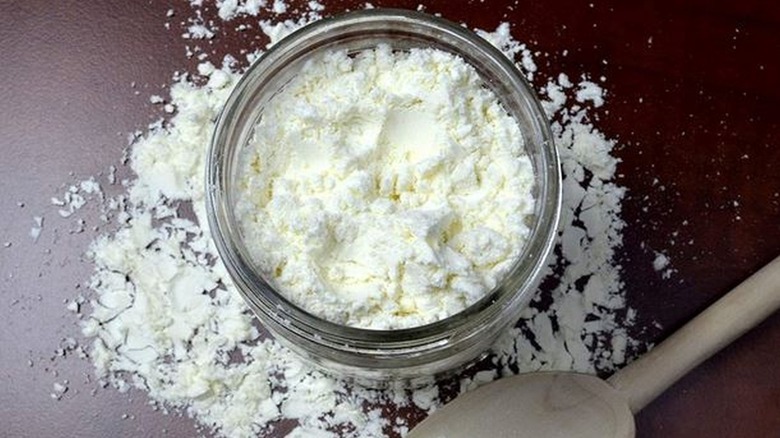What Is Heavy Cream Powder And How Do You Cook With It?
Nearly everyone knows what heavy cream is, and it can be found in supermarkets nationwide. You'll see it sold in small containers in the dairy section. It's sometimes called heavy whipping cream, and it is the richest of the milk products. It gets its richness from having the highest amount of fat out of all milk products, ranging from 36-40%.
Heavy cream powder, a dehydrated version of this dairy product, doesn't enjoy the same level of popularity, but it's a great way to have heavy cream whenever you want to use it. Since the powder is shelf-stable, you can keep it in your pantry to add richness to a soup or a sauce whenever necessary — no more trying to finish a container of cream before it goes bad. Heavy cream powder is an undervalued culinary gem that can be used in various ways.
How is heavy cream powder made?
Fresh heavy cream forms the base for this powder, which is extracted from whole milk. The cream is the fat in the milk that naturally rises to the top. But no dairy company has time to wait for gravity to do the work. To produce enough cream for commercial sales, companies put the milk into machines called separators that spin at high speeds. This creates enough force to separate the cream from the milk. Then, the moisture is removed from the cream, leaving only the cream solids. These solids are turned into a powder.
Depending on the manufacturer, powdered cream may be mixed with nonfat dry or skim milk solids. Some companies add vitamin C and vitamin E as natural preservatives. Others simply sell the dried solids from the cream. In any case, most heavy cream powders have an impressive butterfat level — around 72%. Nutritionally, this translates to anywhere from 1½ to 4½ grams of fat per tablespoon, depending on the brand.
What does heavy cream powder taste like?
Heavy cream powder has a mild, milky taste with a bit of sweetness, much like plain butter. There may be a touch of tang or bitterness as well since the powder has no sugar added to it. Overall, the flavor of heavy cream powder is very subtle.
While it's delicate in flavor, this ingredient works wonders in recipes because it adds so much richness. Because of its fattiness, the powder creates a luxurious mouthfeel to any dish it's incorporated into. Heavy cream powder can make something as simple as scrambled eggs taste creamier, more like a custard. It can give a cheese sauce for macaroni and cheese a smoother finish or take a salad dressing to the next level with its lusciousness. The powder can also help tame the bitterness of a beverage or dish, which is also why cream is such a popular addition to coffee; it takes the edge off.
How to cook with heavy cream powder
Heavy cream powder is a versatile ingredient; use it in its powdered form to make a sauce smoother and richer without diluting it. The powder could take a tomato-based pasta sauce and transform it into a tomato cream sauce. It could also enhance a mushroom gravy or any pan sauce. The powder would work well in soups, too. And for coffee fans, it makes an excellent substitute for fresh cream in your morning cup of joe. It's probably a healthier choice than your standard powdered creamers, which often contain no real cream.
The powder can also be rehydrated to create regular heavy cream so you can have it on hand whenever needed. The trick is blending the water and powder thoroughly and allowing it to sit for a while. The suggested ratio of water to powder seems to vary; some recommend starting with 1 cup of water to ½ cup of powder, while others suggest using a 1-to-1 ratio. Once the reconstituted cream has rested, it will act the same as fresh heavy cream in any recipe.
Where to buy heavy cream powder
You'll unlikely find heavy cream powder in your local supermarket, but it's readily available through many online stores, such as Amazon. Many of the manufacturers sell their product directly through their websites as well. The prices will vary from around $15 to $19 per pound. It's a good investment, considering its impressive shelf life. If stored properly, the powder can last up to two years, so you'll want to keep it in a place that is cool and dry.
It's worth the extra effort to get heavy cream powder. While it's easier to get nonfat dry milk powder, this product wouldn't be a great substitute for its heavy cream counterpart. The lack of fat in the dry milk wouldn't provide the same level of richness as heavy cream powder. And it's that extra fat that helps create that delicious creamy taste.




